Learning About The Different Types of Carpet Dyes and Rug Color Dyestuff:
Carpet Dyes and Rug Dyestuff – Like wool, rugs and carpet dyes may vary considerably in quality, and they may affect the value and desirability of the rug. Some are rich and saturated, others are soft. But good dye will have a transparent quality that lets the color shine in response to light. When combined with lustrous wool, transparent dyes make the color effects come to life.
Inferior dyes are murky and flat. Good dyes are also fast in response to exposure to light or water. Inferior dyes fade in sunlight and run when wet, spoiling the effects of the design.
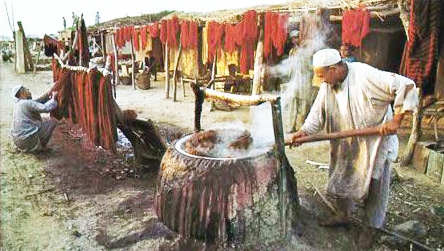
Dying Wool For Weaving Carpets
Antique rugs were made with dyes derived primarily from vegetable materials, although some like lac or cochineal were derived from insect shells. All such dyes were properly fixed not to run when wet or to fade appreciably on exposure to light.
This fixing might take weeks, especially to achieve rich colors. Early synthetic dyes gave bright colors without lengthy fixing, but they were unstable.

Carpet Dyes – A Weaver Dying Wool For Weaving A Rug
Some, like fuchsine purple, faded to grey. Others like aniline red bleed terribly when wet, and they may fade as well. Modern chrome dyes developed after 1920 do not fade or run, but they seldom have the depth and warmth of natural vegetable or insect dyes.
Within the last twenty years weavers in many rug-producing regions have succeeded in reviving the traditional technique of vegetable derived dyes.
How Did They Get Those Colors? Natural Vegetable Dyes vs. Synthetic Dyes
One of the elements that draw us to Persian rugs, particularly antique ones, is the beautiful rug colors and color combinations within them. One of the misconceptions about natural vegetable dyes is that they produce dull colors, but the brilliant reds, royal blues, and earthy browns of antiques are anything but dull. Below, we will explore how rug dyers produced those vibrant colors using natural vegetable rug dyes. We will also examine one of the most important questions when it comes to rug value, how to tell natural dyes from synthetic dyes.
Why Do Natural Dye Colors Work Well Together?
Antique Persian carpets, particularly those produced before 1850, rely only on colors produced from things found in the plant and animal kingdoms. Within Persian carpets, you often find color combinations that would not work well together in any other context, but for some reason, they Persian colors work well in rugs. If you one were to combine the same colors using synthetic dyes, the carpet would appear to be garish and would not work visually. Why is this?
There is a scientific reason why natural and vegetable dye colors work well together. The answer is that natural dyes are not pure colors. Within each natural dye are the elements of all of the primary colors. For instance, madder root is used to produce brilliant red. However, it also reflects blue and yellow, but the red is dominant. Our brain sees red, blue and yellow, but we register it as red.
Because natural plant dyes have all three colors within them, it is easy for them to harmonize and work well together. The same is not true for synthetic or chemical dyes that were designed to be monochromatic and flat. That is, a red synthetic dye only has red and does not contain the yellow and blue elements that would be found in a natural dye.
Another reason why we find the natural dye color so pleasing is that the yarns have a bit of variation that creates texture and depth in the final carpet. These variations are due to variations in hand-spun wool, the source of the plant material, differences in processing the dyestuffs, and differences in the color production process. These variations are not found in synthetic dyes.
Common Rug Dyes and Color Dyestuff
The availability of plant stuff to create the beautiful colors is dependent upon a climate and what is available locally. One often finds a wider range of colors in carpets produced in near the carpet weaving centers. This is because they had access to trade routes and the ability to import dyestuff from different parts of the world. Often, tribal carpets have a limited number of colors available, and the availability of these colors can change, particularly with nomadic tribes who would move to different areas.
However, in general, the following plants are used to produce certain dye color ranges.
How Is Red Color Dyestuff Produced?
The most common dyestuff used to produce red color dye is the root of the madder plant. However, some red colors are produced from the carapace is of a certain type of insect, called cochineal (see below). Madder produces a more orange-red, but cochineal produces a more burgundy red. Cochineal was used in Spanish rugs, and the red produced became known as “Spanish red.” Safflower is also used to produce reds in some areas, but this dyestuff does not tend to be light fast and will fade in time.
How Is Blue Color Dyestuff produced?
The leaves of the indigo plant are the oldest, and most common source, for blue dyes. They are still used to provide the characteristic color of blue jeans. The leaves are picked and must be fermented to produce a brilliant color.
How Is Yellow Color Dyestuff Produced?
Yellow dyes come from weld and larkspur. Pomegranate peel was also used to produce certain yellow colors.
How Is Green Color Dyestuff Produced?
Green dyes are often produced by double dying the yarn first in larkspur , Saffron or weld and then in indigo. There are many sources of green in the plant world, but many of them will fade quickly in the light. Making a good and pleasing green dye is not easy and usually takes a mater dyer to create a good shade. The double dying process also takes longer and costs more. That is why green colored rugs are quite rare and weavers would not typically make green unless they had some sort of custom rug order which would enable them to charge more for the rug.
How Is Orange Color Dyestuff Produced?
Orange dye colors were produced from henna leaves, and also by over-dying madder red with weld yellow. Saffron was also used in certain parts of the world to produce a range of oranges and yellows.
Yellow Gold / Orange Colored Rugs
How Is Purple Color Dyestuff Produced?
Purple dyes were generally derived from hollyhocks, but this dyestuff also proved not to be light-fast. A more stable and light-fast dye was produced from a gland in a particular sea snail, called murex. Fabrics dyed with this substance were once some of the most expensive in the world.
How Is Brown Color Dyestuff Produced?
Brown dyes are produced from walnut hulls, oak bark and other nutshells. However, for some brown colors, the wool of brown sheep was used and left undyed.
How Is Black Color Dyestuff Produced?
Black dye is often produced by starting with dark wool and then over-dying it with blues, reds, and yellows. Sometimes iron salts were used, but these tend to deteriorate and oxidize the wool quickly.
Black and Or Grey Colored Rugs
How to Tell Natural Vegetable Dyes from Synthetic or Chemical Dyes
The production of synthetic dyes began out of a desire to produce colors that were more even, uniform and standardized. There was a desire to have more control over the dying process and the material used. The first synthetic dyes were invented in 1850’s. They began to appear in antique textiles and carpets as early as the 1860’s and were widely available by 1900. If the carpet was produced prior to around 1860, it was produced using all natural and vegetable dyes. However, age is not the best indicator of what type of dyestuff was used. Just because it is a modern rug does not necessarily mean that synthetic or chemical dyes were used to produce the color. There have been several times when artists drifted back to natural dyes because of the characteristics they produced.
Of course, it is possible to have a sample of the fiber tested by a laboratory, which is the most definitive way of determining the dye used in a carpet. However, this is expensive and impractical in most situations. It is possible to learn to identify natural dyestuffs using the eye alone. Most rug collectors, dealers, and art house staff have considerable experience in determining whether the carpet was dyed with natural or synthetic dyes. This comes from years of experience and looking at thousands of carpets over their lifetime.
Here are a few tips and techniques to help you tell natural dyes apart of synthetic dyes.
One of the best ways to spot a synthetically dyed carpet from a natural one is to spread apart the pile and look at the color over the length of the fiber. Chemical dyes tend to fade in light quicker than natural dyes. If the roots of the carpet near the foundation are much much darker and there is considerable amount of fading at the tip of the pile, then it is probably a synthetic dye. If you turn the carpet over and the colors on the back are so much more dark than the colors on the front, then it is more likely a synthetic dye that has been exposed to light and the colors of the rug have faded over time.
Beware of Bright Dye Colors
Carpets that have bright and vibrant pops of solid oranges, greens and purples are more likely to be chemical dyes, particularly if no variation in color is seen across the area. These colors are more difficult to produce using natural dyes.
Naturally dyed wool will almost always have variations that are called abrash. The subtle changes in shade are the imperfections that give natural colors their subtle charm. If the color is completely uniform and monochromatic, it is more likely the perfection that is produced by modern chemistry. If the colors are harsh and shiny, they are more likely to be the result of chemical dyes. However, this is not always the case. Some silk carpets can come very close to the bright, even colors found in synthetically dyed carpets. This is where an expert will come in handy.
The development of natural dyes was a process of experimentation. The most common natural dyestuffs that were used throughout the Middle Ages and even before that were the result of seeing what worked and faded, and what did not. The most common commercial dyes were those that proved to be the most stable, fade-resistant, and produced the most vibrant colors. Others failed to reach market viability. In general, natural dyes are more fade resistant than synthetic dyes. This is why we have 400- year-old carpets that are just as bright as the day they were produced.
Carpets produced using natural dyes have a character that cannot be reproduced using synthetic dyes. That is why we love them so much and why we stand in awe at the beautiful colors and patterns that we find in these priceless historical treasures. The unpredictability of the dyeing process is something that makes these carpets even more beautiful than the perfectly even modern colors produced by a machine.
We are fortunate to have some beautiful carpets that use fantastic color combinations in our collection. Feel free to search our rugs online and enjoy the garden of colors and artistry that is available. Perhaps, you will find a unique carpet with the perfect color to complete your room.
Learning about Rug Dyes and Dyeing Techniques Used In Weaving Persian Rugs
Sheep wool may be either a light off-white ivory color, or a dark brown to black. Both may be used in Persian rug weaving, but it is the ivory wool that is most easily altered through the process of dyeing to produce poly chromatic textiles and rugs. The earliest traditional dyes were those made from various vegetable sources. These were mixed with water in a liquid form to allow the fibers to soak, often for a substantial period.
After soaking, however, the dyes had to be ‘fixed’ with a ‘mordant’. The solution was made from various metallic salts that bind the colors to the fibers. This process will stabilize the rug dyes so that they won’t not bleed or run when rug is washed or wet, and so that they will not fade with time upon exposure to sunlight. The same vegetable dye can produce different rug colors by using different mordants. In this way, for example, the madder plant will yield a range of reds, oranges, and purples. Yellow is made from saffron or weld. Blue was traditionally made with indigo. Green was made by overdyeing indigo with weld or by mixing indigo or cobalt with saffron. Various shades of red or violet were also made from insect dye or lac, derived from the shells of beetles. An example would be the red cochineal bug dyes.

The dried bodies of cochineal bugs are used to make vibrant red dye.
The production of Persian rugs had always favored a wide range of color and a taste for rich, saturated tones. The Persian rug dyers became famed for their ability to achieve these effects despite the challenges and limitations imposed by the vegetable dying processes.
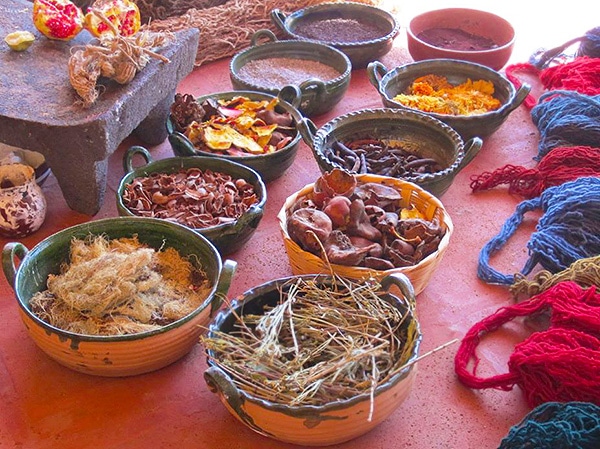
natural materials, minerals and plats for making Persian rug dyes
Around the mid 19th century, the first chemical dye, fuchsine, was discovered by mistake during a chemist’s lab experiment. By the later part of the nineteenth century, European chemists had succeeded in manufacturing new synthetic dyes of aniline and azo type that produced various shades of red, yellow, and the magenta called fuchsine (named after the dye itself) and mauvine purples.
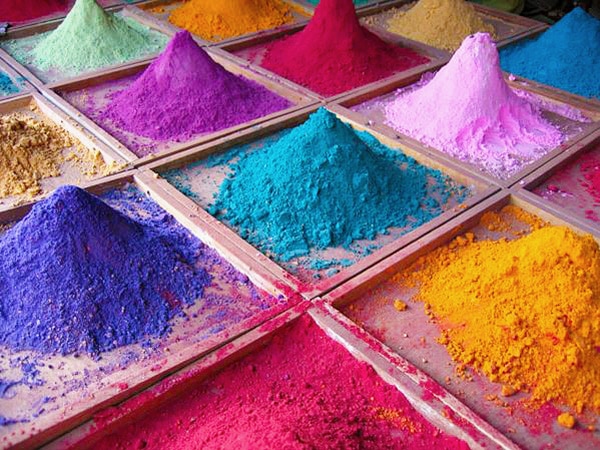
Vibrant Colorful Rug Dyes Pigments
These first generation chemical dyes appeared to have the advantage of yielding vibrant jewel tone colors, that, at times, tends to come out harsh, within a relatively short time. But they proved unstable. These dyes have a tendency of running when wet and they faded a lot upon exposure to light, or both. Consequently, this early generation of synthetic dyes had a devastating effect upon late nineteenth and early twentieth century rug production across the Middle East. Also, through access to old stockpiles, such dyes continued to affect rug production even decades later.
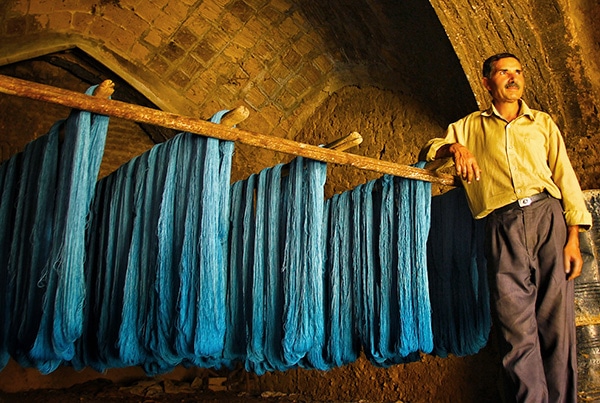
Persian Family Rug Wool Dyeing Business in Kashan Iran
In the 1930’s, however, a new generation of ‘chrome’ or alizarin synthetic dyes emerged. Mordanted with potassium bichromate dyes proved to be much more reliable. Their color could be better controlled, avoiding the harshness of the earlier synthetics, and they proved very stable in reaction to light and water. These more modern rug dyes also made it possible to produce larger quantities of dyed wool in consistent shades.
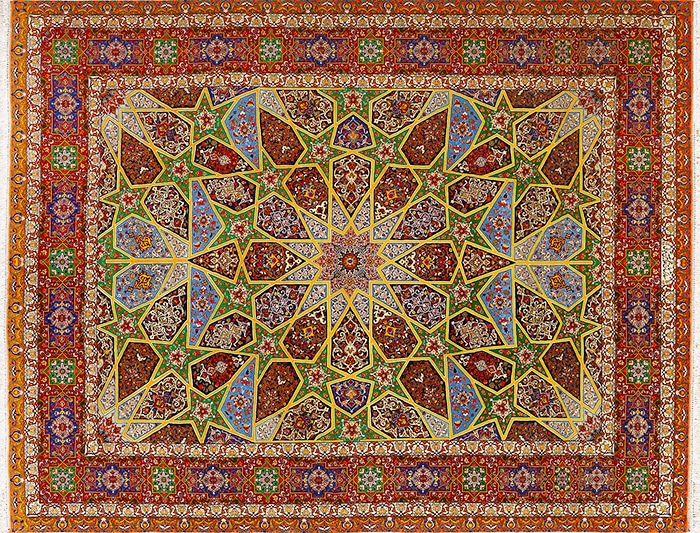
Vintage Persian Rug With Modern Dyes
With vegetable dyes it had been difficult to control the tones uniformly so that weavers were compelled to use different shades of a given color within the design. In time this variegated ‘abrash’ effect came to be appreciated as a virtue or textile art element in and of itself, but it still remains a matter of taste. Chrome dies gave rug weavers a greater control over their palette. Starting in the period between and continuing after the two world wars, Persian workshops used them to make rugs whose color was a fast and durable as it was rich and beautiful.
During the last several decades there has also been a movement to revive traditional vegetable dyeing techniques, which are now used alongside the newer, state-of-the-art synthetics as seen in the more recent and finer productions of modern and vintage Persian rugs.

